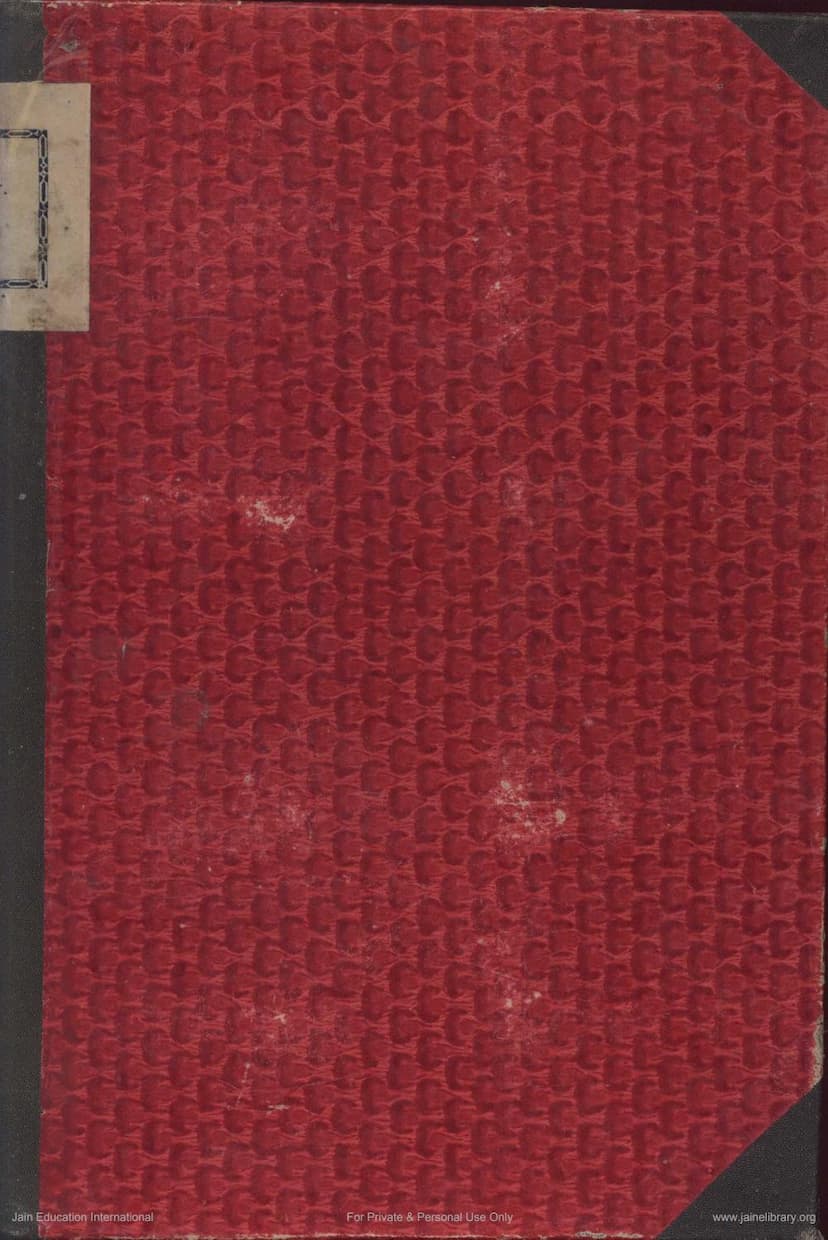Vasudevhindi Part 1
Added to library: September 2, 2025

Summary
Here's a comprehensive summary of the provided Jain text, "Vasudevhindi Part 1," based on the provided pages:
Book Title: Vasudevhindi Part 1 Author(s): Sanghdas Gani, Chaturvijay, Punyavijay Publisher: Atmanand Jain Sabha Catalog Link: https://jainqq.org/explore/001888/1
Overall Context:
The provided text is the introductory section and the beginning of the first part of the Vasudevhindi, a significant Jain narrative work. It appears to be an edition published by the Shri Jain Atmanand Sabha, Bhavnagar, in Veer Samvat 2456 (Vikram Samvat 1986, AD 1930). The text is in Gujarati, with occasional Sanskrit or Prakrit terms and grammatical structures. The edition is edited and researched by Chaturvijay and Punyavijay, disciples of Shri Kantivijay Muni.
Key Sections and Information:
-
Title and Authorship: The title Vasudevhindi Part 1 (प्रथम खंड) is clearly stated. The work is attributed to Shri Sanghdas Gani, with the current edition prepared by Chaturvijay and Punyavijay. The introductory "Prastavik Nivedan" (Preliminary Statement) highlights that the work was initially intended to be published by the Devchand Lalbhai Jain Pustakoddhar Fund but was taken over by the Atmanand Jain Sabha due to financial reasons.
-
Structure of Vasudevhindi: The Vasudevhindi is described as a vast work comprising two parts, totaling 100 lambhakas (sections/chapters) and estimated to contain 28,000 shlokas (verses).
- Part 1: Contains 29 lambhakas and approximately 11,000 shlokas.
- Part 2: Contains 71 lambhakas and approximately 17,000 shlokas.
- It's noted that the two parts were not composed by a single author but by different Jain Acharyas. Part 1 is by Shri Sanghdas Gani, and Part 2 is by Shri Dharamsen Gani Mahattar. The editors anticipate that Part 1 might be incomplete, with an estimated 1,000 shlokas missing from the recorded count.
-
Content of the First Part (First Section): The current publication, the "Pratham Ansh" (First Section), covers up to the seventh lambhaka. It follows the initial classification of the main text into six major sections: Kahupatti, Pedhiya, Muhan, Padimuhan, Sharir, and Upsanharo. This first part includes the entirety of the Kahupatti section and the first seven lambhakas of the Sharir section.
-
"Dhammillhindi" Inclusion: The title is Vasudevhindi, but the text explicitly states that it contains descriptions of both Dhammillhindi and Vasudevhindi. Dhammillhindi follows the Kahupatti section, but the majority of the text is dedicated to Vasudevhindi, hence the title.
-
Manuscripts Used: The editors mention using several manuscripts for their research and correction, noting abbreviations like 'Li', 'Ya', 'De', 'Ka', 'Mo', 'Sa', 'Go', 'Va', 'Kha', 'U'. They express gratitude to the libraries and individuals who provided these valuable texts.
-
Editorial Symbols and Notations: The introduction explains the symbols used in the edition:
(): Corrected words or phrases based on the editors' understanding.[]: Inserted text to complete fragmented passages.[ * ]: Words considered errors in the original manuscripts, indicated with an asterisk.(?)or(??): Used for uncertain words or passages.saṁ: Indicates corrections made by scholars in the margins or within the text of the manuscripts.•(dot): Used as a full stop within parentheses for clarity in dialogues like "Vasudevena bhanium" or "Maya bhanium".- Marginal English numerals: For line counting.
- Shloka Count: The shloka counts indicated in the text are not from the original manuscripts but were added by the editors based on their own counting.
-
Praise for Editors and Publishers: The Prastavik Nivedan and Aabhar Pradarshan (Acknowledgement) sections express deep gratitude to the editors (Munishri Chaturvijayji and Munishri Punyavijayji) for their dedicated work and to the patrons and the Shri Jain Atmanand Sabha for their support in publishing this first section with high-quality paper and printing at Nirnaya Sagar Press.
-
Content Overview (First Part/Section):
- Dhammillhindi: This section begins with the story of Dhammil.
- Pedhiya: This section appears to be a foundational or introductory narrative.
- Muhun: This section seems to focus on specific narratives.
- Padimuhan: Another narrative section.
- Sharir: This large section starts with the Saamavijayalambho (First narrative).
- Kahupatti: This section seems to focus on the origin and lineage of events, including stories like Jambuswami Charitra, Vanar Kahā, Lalita Anganaayā, Jiyashatru's story, Mehesaradatta's story, Nandipura's story, Nandisen's story, Raghav's story, Vasudev's story, and Krishna's story. It also includes the beginning of the Vasudev Charitra itself, detailing the lineage and birth of Vasudeva. The stories often serve as allegories or moral teachings.
- NilaJasa Lambha: Features tales like the conversation between Charudatta and the dancer Vasantsena, and the story of the elephant tamer.
- Somashri Lambha: Includes the story of charudatta's encounters, Vasudev's past lives, and the birth of Sombha.
- Mitra-Dhanashri Lambha: Details the story of Charudatta's interactions with friends and family, and the stories of Vidudatta and Vasudev.
- Kabila Lambha: Focuses on the story of Kabila and her encounters, and the origin of certain customs.
- Nilajsa Lambha: Covers stories related to Nilajsa and her family.
- Abhimanyu's story: This section seems to describe events related to Abhimanyu.
- Samishri's story: Details the story of Samishri.
- Vasudev's past lives: The text frequently delves into the past lives of characters to illustrate moral and ethical principles, as seen in the stories of Vasudev, Sambha, and others, tracing their karmic journeys.
- Nandisena's story: Describes Nandisena's previous births and his journey toward spiritual enlightenment.
- Dhammil's story: An extensive narrative about Dhammil's life, renunciation, and teachings.
- Abhimanyu's story: The narrative of Abhimanyu.
- Chirudatta's story: A detailed account of Charudatta's life, his interactions, and the consequences of his actions.
Significance:
The Vasudevhindi is a monumental work in Jain literature, known for its rich narrative style and the depth of its philosophical and ethical teachings, often presented through intricate stories and allegories. This edition represents a scholarly effort to make this ancient text accessible to a wider audience. The detailed introduction and editorial notes showcase the meticulous research involved in bringing forth this part of the Vasudevhindi.